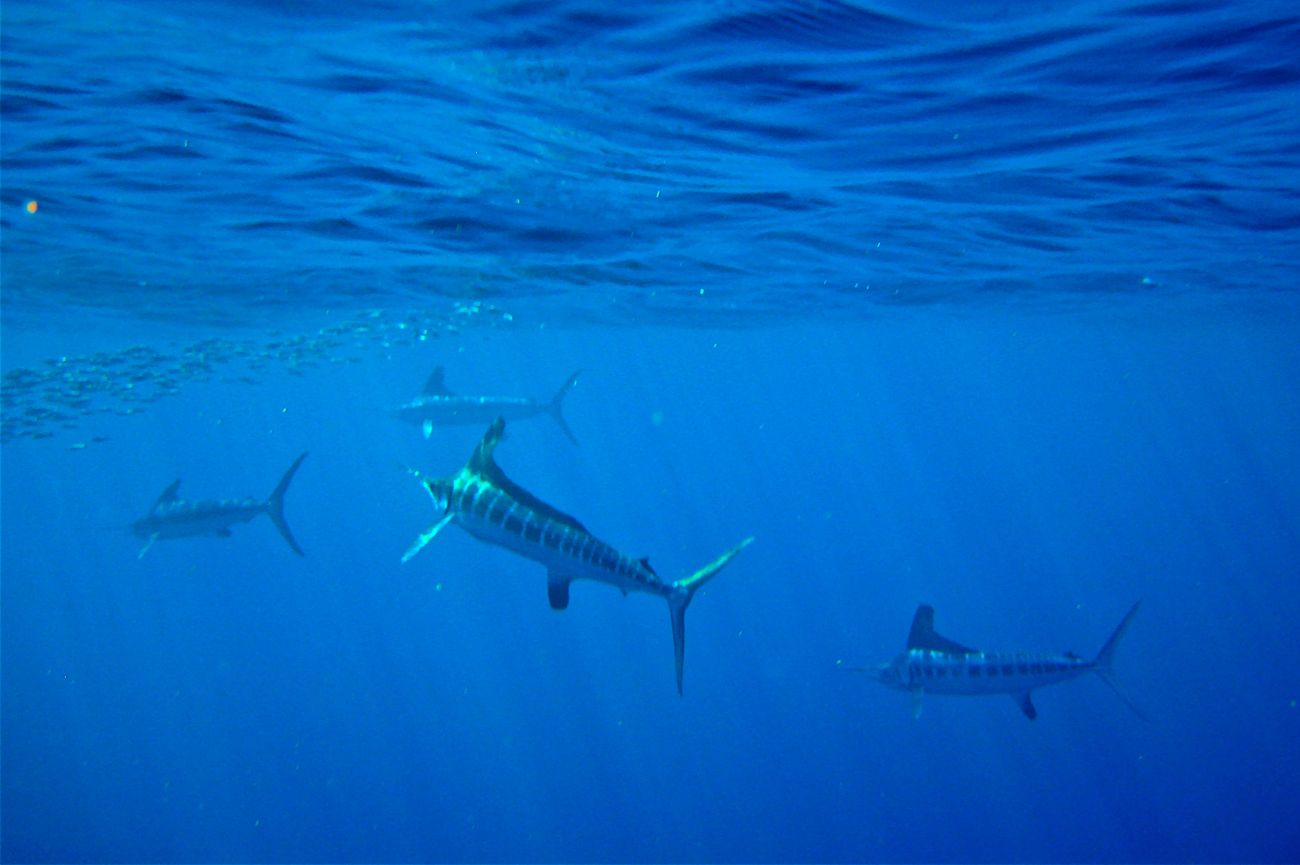Blue Marlin, Makaira nigricans Lacépède 1802

Blue Marlin, Makaira nigricans. Source: J Thomas McMurray / Flickr. License: CC BY Attribution-Noncommercial
A bluish-black marlin fading to silvery white below, with about 15 rows of pale cobalt blue stripes, first dorsal fin dark blue to blackish, other fins brownish-black with a tinge of dark blue in some, anal fin base silvery white.
Watch 'Superfish' by the BBC Wildlife Unit.
Amazing footage of a Blue Marlin attacking a Mahi Mahi (aka Dorado), Coryphaena hippurus, off Costa Rica.
Blue Marlin, Makaira nigricans Lacépède 1802
More Info
|
Distribution |
Found in all Australian coastal areas with the exception of South Australia. Elsewhere, in tropical and sub-tropical waters worldwide, ranging into temperate waters, with the distribution centred on equatorial regions. An epipelagic, oceanic species which migrates to higher latitudes during the summer; rarely found close to shore or islands, unless near deep drop-offs. Small schools of 10 individuals or less have been observed, though larger individuals tend to be solitary. |
|
Features |
Meristic features: Dorsal fin 40-45 + 6-7; Anal fin 12-17 + 6-7; Pectoral fin 20-23. Body elongated and not very compressed. Bill long, strong and circular in cross section. Jaws and palatine with fine, file-like teeth. Gill rakers absent. Pelvic fins shorter than pectorals, pectoral able to be folded against body. Single lateral line with distinctive single loop pattern, becoming obscured by scales in larger adults. Scales heavily ossified, long, with 1-3 points posteriorly. |
|
Size |
Reaches a length of at least 500 cm and a weight of 900 kg. Maximum age at least 20 years. Female Blue Marlin grow faster, and reach a larger size than males. |
|
Colour |
Bluish-black above, silvery-white below with about 15 pale blue vertical bands along sides, each consisting of dots or bars. First dorsal fin blackish-brown to dark blue, remaining fins dark brown to black, sometimes dark blue. Base of anal fins silvery white. |
|
Feeding |
Uses its bill to slash and stab prey. Commonly feed at or near the surface on scombrid and carangid species, but also hunts deeper, demersal fish species. Also known to feed on cephalopods. The diet appears to vary with region. |
|
Biology |
Batch spawners. Spawn during summer/autumn at fringes of coral reefs. Ripe ovarian eggs are between 0.8 and 0.9 mm in diameter. Genetic evidence suggest a single world-wide species of Blue Marlin, separated into Atlantic and Indo-Pacific stocks. Some authors have treated the stocks as separate species on the basis of different dorsal fin ray counts and distinctive lateral-line differences. |
|
Fisheries |
In Australia, this species is usually taken as bycatch by commercial tuna longlines, but is not retained, and also forms an important component of the recreational gamefishing fishery. Elsewhere in the Pacific, the fishery for the blue marlin is considered fully exploited. |
|
Similar Species |
Best separated from the Black Marlin (Makaira indica) by the Blue Marlin's lower first dorsal fin (less than maximum body depth) and the former's rigid pectoral fins. |
|
Species Citation |
Makaira nigricans Lacepède 1802, Historie naturelle des poissons. 4: 688, Pl. 13 (fig. 3). Type locality: Ile de Ré, Bay of Biscay, France. |
|
Author |
Schultz, S. |
Blue Marlin, Makaira nigricans Lacépède 1802
References
Carpenter, K.E.; Niem, V.H. (eds). FAO species identification guide for fishery purposes. The living marine resources of the Western Central Pacific. Volume 6. Bony fishes part 4 (Labridae to Latimeriidae), estuarine crocodiles, sea turtles, sea snakes and marine mammals. Rome, FAO. 2001. pp.3381-4218.
Fritsches KA, Marshall NJ, Warrant EJ (2003) Retinal specializations in the blue marlin: eyes designed for sensitivity to low light levels. Marine and Freshwater Research 54: 333–341.
Graves, J.E. & J.R. McDowell. 2003. Stock structure of the world's istiophorid billfishes: a genetic perspective. Marine and Freshwater Research 54: 287-298.
Habegger, M.L., M.N. Dean, J.W.C. Dunlop, G. Mullins, M. Stokes, D.R. Huber, D. Winters & P.J. Motta. 2015. Feeding in billfishes: inferring the role of the rostrum from a biomechanical standpoint. Journal of Experimental Biology 218: 824-836. doi: 10.1242/jeb.106146
Hoese, D.F., D.J. Bray, J.R. Paxton, & G.R. Allen. 2006. Fishes. in Beesley, P.L. & A. Wells. (eds) Zoological Catalogue of Australia. Volume 35. ABRS & CSIRO Publishing: Australia. parts 1-3, pages 1-2178.
Kleiber, P., M.G. Hinton & Y. Uozimu. 2003. Stock assessment of blue marlin (Makaira nigricans) in the Pacific using MULTIFAN-CL. Marine and Freshwater Research 54: 349-360.
Leis, J.M., B. Goldman & S. Ueyanagi. 1987. Distribution and abundance of Billfish larvae (Pisces: Istiophoridae) in the Great Barrier Reef Lagoon and Coral Sea near Lizard Island, Australia. Fishery Bulletin 85(4): 757-765.
Nakamura, I. 1974. Some aspects of the Systematics and Distribution of Billfishes. In Shomura, R.S. & F. Williams (editors), Proceedings of the International Billfish Symposium, Kailua-Kona, Hawaii, 9-12 August 1972, Part 2. Reviewed and contributed papers. NOAA Technical Report. NMFS SSRF-675.
Nakamura, I., FAO species catalogue. Vo1.5. 1985. Billfishes of the World. An annotated and illustrated catalogue of marlins, sailfishes, spearfishes and swordfishes known to date. FAO Fish.Synopsis. No.125, Vo1.5: 65 p.
Shimose, T., K. Yokawa, H. Saito & K. Tachihara. 2007. Evidence for the use of the bill by blue marlin, Makaira nigicans, during feeding. Ichthyological Research 54: 420-422.
Speare, P. 2003. Age and growth of black marlin, Makaira indica, in east coast Australian waters. Marine and Freshwater Research 54: 307-314.






